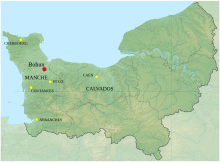|
Humphrey with the BeardHumphrey with the Beard (died before 1113) was a Norman soldier and nobleman, the earliest known ancestor of the de Bohun family, later prominent in England as Earls of Hereford and Earls of Essex.  His epithet, "with the beard" (cum barba), was a distinguishing one in eleventh-century Normandy, where the custom was to shave the face and back of the head. It is first recorded in a later chronicle of Llanthony Prima, edited by William Dugdale in the Monasticon Anglicanum (VI.134):
As is stated by Wace in the Roman de Rou, Humphrey derived from "Bohun" in Normandy: De Bohun le Vieil Onfrei ("from Bohun the old Humphrey").[2] Today this holding comprises two communes, Saint-André-de-Bohon and Saint-Georges-de-Bohon. He donated a plough and garden to the nuns of the Abbaye Saint-Amand at Rouen. The charter was witnessed by William, Duke of Normandy as Comes ("Count"), placing the gift before the 1066 Norman conquest of England. He later donated the church of Saint-Georges-de-Bohon to the Abbey of Marmoutier. After the conquest, he received lands in England including his seat at the manor of Tatterford in Norfolk, as recorded in the Domesday Book of 1086. His donation to Abbaye Saint-Amand indicates he had been married three times, but the names of his wives are unknown. He had three sons and two daughters, including:
References
Sources
|